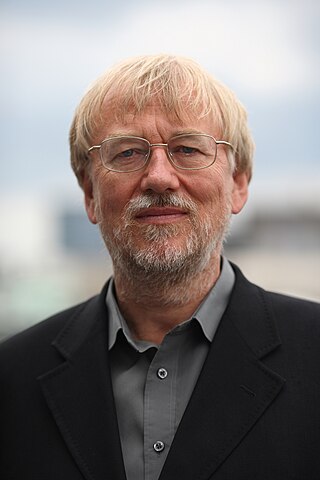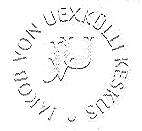Related Research Articles
Semiotics is the systematic study of sign processes (semiosis) and meaning making. Semiosis is any activity, conduct, or process that involves signs, where a sign is defined as anything that communicates something, usually called a meaning, to the sign's interpreter. The meaning can be intentional, such as a word uttered with a specific meaning; or unintentional, such as a symptom being a sign of a particular medical condition. Signs can also communicate feelings and may communicate internally or through any of the senses: visual, auditory, tactile, olfactory, or gustatory (taste). Contemporary semiotics is a branch of science that studies meaning-making and various types of knowledge.
Psychosomatic medicine is an interdisciplinary medical field exploring the relationships among social, psychological, behavioral factors on bodily processes and quality of life in humans and animals.

Francisco Javier Varela García was a Chilean biologist, philosopher, cybernetician, and neuroscientist who, together with his mentor Humberto Maturana, is best known for introducing the concept of autopoiesis to biology, and for co-founding the Mind and Life Institute to promote dialog between science and Buddhism.

Teleology or finality is a reason or an explanation for something which serves as a function of its end, its purpose, or its goal, as opposed to something which serves as a function of its cause.
The year 1944 in science and technology involved some significant events, listed below.
The year 1864 in science and technology included many events, some of which are listed here.
Biosemiotics is a field of semiotics and biology that studies the prelinguistic meaning-making, biological interpretation processes, production of signs and codes and communication processes in the biological realm.

Jakob Johann Freiherr von Uexküll was a Baltic German biologist who worked in the fields of muscular physiology and animal behaviour studies and was an influence on the cybernetics of life. However, his most notable contribution is the notion of Umwelt, used by semiotician Thomas Sebeok and philosopher Martin Heidegger. His works established biosemiotics as a field of research.

In the semiotic theories of Jakob von Uexküll and Thomas A. Sebeok, umwelt is the "biological foundations that lie at the very center of the study of both communication and signification in the human [and non-human] animal". The term is usually translated as "self-centered world". Uexküll theorised that organisms can have different umwelten, even though they share the same environment. The term umwelt, together with companion terms Umgebung and Innenwelt, have special relevance for cognitive philosophers, roboticists and cyberneticians because they offer a potential solution to the conundrum of the infinite regress of the Cartesian Theater.

Carl Wolmar Jakob Freiherr von Uexküll is a writer, lecturer, philanthropist, activist and former politician. He served as a member of the European Parliament from 1987 to 1989 representing the German Green Party. In 1980, Uexkull founded the Right Livelihood Award, and in 2006, he co-founded the World Future Council. Born in Sweden, he holds both Swedish and German citizenship, and is a resident of the United Kingdom.
The semiosphere is an idea in biosemiotic theory proposing that, contrary to ideas of nature determining sense and experience, the phenomenal world is a creative and logical structure of processes of semiosis where signs operate together to produce sense and experience.

Hans Lissmann FRS was a British zoologist of Ukrainian provenance, specialising in animal behaviour.

Jesper Hoffmeyer was a professor at the University of Copenhagen Institute of Biology, and a leading figure in the emerging field of biosemiotics. He was the president of the International Society for Biosemiotic Studies (ISBS) from 2005 to 2015, co-editor of the journal Biosemiotics and the Springer Book series in Biosemiotics. He authored the books Biosemiotics: An Examination into the Signs of Life and the Life of Signs and Signs of Meaning in the Universe and edited A Legacy for Living Systems: Gregory Bateson as Precursor to Biosemiotics.

Jakob von Uexküll Centre is an Estonia-based organisation for the work with the legacy of biologist, philosopher and semiotician Jakob von Uexküll. The Centre owns the major archive of his works in the world.

Puhtu is a former islet and since the beginning of the 19th century a peninsula in western Estonia. Administratively it belongs to Virtsu small borough in Lääneranna Parish, Pärnu County.
Ecosemiotics is a branch of semiotics in its intersection with human ecology, ecological anthropology and ecocriticism. It studies sign processes in culture, which relate to other living beings, communities, and landscapes. Ecosemiotics also deals with sign-mediated aspects of ecosystems.
Copenhagen–Tartu school of biosemiotics is a loose network of scholars working within the discipline of biosemiotics at the University of Tartu and the University of Copenhagen.
Critical anthropomorphism refers to a perspective in the study of animal behavior that encompasses using the sentience of the observer to generate hypotheses in light of scientific knowledge of the species, its perceptual world, along with ecological and evolutionary history. The term is of particular relevance to mentalistic behavioral mechanisms, and its application involves using "natural history, our perceptions, intuitions, feelings, careful behavioral descriptions, identifying with the animal, optimization models, previous studies and so forth in order to generate ideas that may prove useful in gaining understanding and the ability to predict outcomes of planned (experimental) and unplanned interventions".
Puhtu Biological Station is a research station located in Pärnu county Lääneranna Parish, Estonia, at the coast of Baltic Sea. It is one of the oldest biology stations in Estonia.
Emilie Kiep-Altenloh (1888–1985) was a German sociologist and politician.
References
- ↑ Rodney A. Brooks (1991). "Intelligence without representation". Artificial Intelligence. 47 (1–3): 139–159. CiteSeerX 10.1.1.308.6537 . doi:10.1016/0004-3702(91)90053-M.
- ↑ Caputi AA, Budelli R (June 2006). "Peripheral electrosensory imaging by weakly electric fish". J. Comp. Physiol. A. 192 (6): 587–600. doi:10.1007/s00359-006-0100-2. PMID 16501980.
- ↑ Jakob von Uexküll, Mondes animaux et monde humain